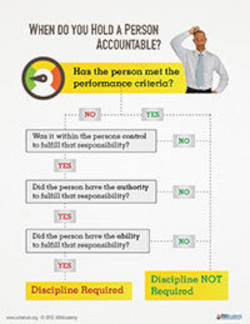Element 5: Appropriate Application of Consequences
In addition to an expectation of consequences, they must also meet certain criteria to be appropriate.
Three Important Criteria for Appropriate Consequences
- They are justified.
- They correspond to the degree of positive or negative results of the behavior.
- They are applied consistently throughout the entire organization.
Are Consequences Justified?
Employees should be held accountable for their performance only if they have sufficient control of the resources and ability to perform. Holding employees accountable for outcomes beyond their control can lead them to seek control through inappropriate means. For instance, supervisors focused solely on maintaining low department accident rates might resort to threatening dismissal for filing OSHA injury reports. Such tactics are not only counterproductive, but also illegal.
Employees may have little control over their work schedules, the quality of materials provided, work assignments, production quotas, and co-workers. On the other hand, complying with safety procedures, policies, and rules are personal behaviors over which they have some degree of control. Control also implies that employees can choose to meet expectations or choose to "do it their way." The decision is theirs to make and the degree to which they have control over their performance, determines the nature of the resulting consequences.
Do Consequences Correspond to the Impact of Behaviors?
Consequences should correspond with the resulting positive or negative impact of performance. If employees perform unsafe work practices that could result in fatal injuries, that certainly warrants a serious consequence. On the other hand, minor safety rule violations, unlikely to lead to injury or illness, may necessitate less severe consequences. The application of progressive discipline, in such cases, demands careful deliberation.
Consequences should increase as employees assume greater levels of responsibility. Disciplinary action may be necessary when employees fail to adhere to safe work practices, such as wearing eye protection. However, the same infraction by supervisors or managers should warrant a more stringent disciplinary response due to their higher positions of responsibility. In effect, supervisors or managers set a precedent for all employees. A violation of safety rules by those in leadership roles can have a far more detrimental impact on overall workplace safety, as it implicitly endorses unsafe practices among employees.
On the other hand, if employees, supervisors, or managers do something positive, the net positive impact should be considered and result in recognition and/reward corresponding to the degree to which their performance improved safety.
Are Consequences Applied Consistently?
To build a high level of trust between management and labor, consequences, both positive and negative, must be applied consistently at all levels of the organization's workforce and management. Again, it is vital to remember that accountability for employees and managers should be limited to aspects of performance within their control.
Knowledge Check Choose the best answer for the question.
6-7. Consequences should _____ as the severity of the negative impact of an unsafe behavior increases.
You forgot to answer the question!

